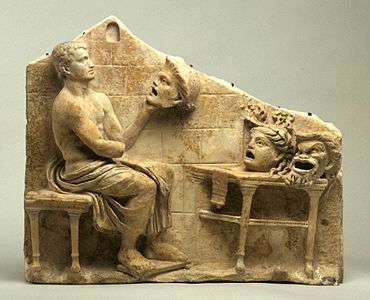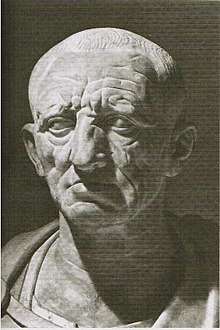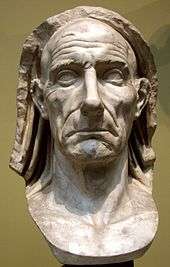Roman Republican portraiture
Roman Republican portraiture was practiced during the period of the Roman Republic (500–27 BC). Examples of Roman portraiture, both sculpture and painting, are more abundant for the Imperial period. Republican portraiture is characterized by verism influenced by Hellenistic portraiture, and survives mainly as marble and bronze sculpture. Roman portrait busts are thought to derive in part from death masks or funerary commemorations, as elite Romans displayed ancestral images (imagines) in the atrium of their home (domus).
 The bronze bust of Lucius Junius Brutus, the Capitoline Brutus in the Musei Capitolini, dated late 4th century BC to early 3rd century BC
The bronze bust of Lucius Junius Brutus, the Capitoline Brutus in the Musei Capitolini, dated late 4th century BC to early 3rd century BC The Orator, c. 100 BC, an Etrusco-Roman bronze statue depicting Aule Metele (Latin: Aulus Metellus), an Etruscan man wearing a Roman toga while engaged in rhetoric; the statue features an inscription in the Etruscan alphabet
The Orator, c. 100 BC, an Etrusco-Roman bronze statue depicting Aule Metele (Latin: Aulus Metellus), an Etruscan man wearing a Roman toga while engaged in rhetoric; the statue features an inscription in the Etruscan alphabet- Scipio Africanus, bronze bust, mid 1st century BC
- The Grave relief of Publius Aiedius and Aiedia, 30 BC, Pergamon Museum (Berlin)

 Roman, Republican or Early Imperial, Relief of a seated poet (Menander) with masks of New Comedy, 1st century BC – early 1st century AD, Princeton University Art Museum
Roman, Republican or Early Imperial, Relief of a seated poet (Menander) with masks of New Comedy, 1st century BC – early 1st century AD, Princeton University Art Museum The Patrician Torlonia bust depicting Cato the Elder, 1st century BC
The Patrician Torlonia bust depicting Cato the Elder, 1st century BC The Osimo head, 1st century BC
The Osimo head, 1st century BC Veristic portrait bust of an old man, head covered (capite velato), either a priest or paterfamilias (marble, mid-1st century BC)
Veristic portrait bust of an old man, head covered (capite velato), either a priest or paterfamilias (marble, mid-1st century BC) Head of an old Roman, c. 60 BC. The realistic rendering of old age (baldness, face and neck wrinkles) corresponds to the esthetic ideal of the end Republic.
Head of an old Roman, c. 60 BC. The realistic rendering of old age (baldness, face and neck wrinkles) corresponds to the esthetic ideal of the end Republic.- The so-called "Togatus Barberini": a Roman senator holding the imagines (effigies) of deceased ancestors in his hand. Marble, late 1st century BC; head (not belonging): middle 1st century BC.
- A funerary relief with members of the gens Vibia, late 1st century BC.
- A Roman marble bust of Cleopatra VII of Ptolemaic Egypt, c. 50-30 BC (around the time of her visit to Rome with Julius Caesar)[1][2][3]
.jpg) The Tusculum portrait of Julius Caesar, 50–40 BC
The Tusculum portrait of Julius Caesar, 50–40 BC
See also
References
- ↑ Raia, Ann R.; Sebesta, Judith Lynn. (September 2017). "The World of State". College of New Rochelle. Accessed 6 March 2018.
- ↑ "Cat. 22 Tetradrachm Portraying Queen Cleopatra VII". Art Institute of Chicago. Accessed 6 March 2018.
- ↑ Grout, James. (April 1, 2017). "Was Cleopatra Beautiful?". Encyclopaedia Romana. University of Chicago. Accessed 6 March 2018.
Bibliography
- Ranuccio Bianchi Bandinelli & Mario Torelli, L'arte dell'antichità classica, Etruria-Roma, Utet, Turin 1976.
- Pierluigi De Vecchi & Elda Cerchiari, I tempi dell'arte, volume 1, Bompiani, Milan 1999
This article is issued from
Wikipedia.
The text is licensed under Creative Commons - Attribution - Sharealike.
Additional terms may apply for the media files.